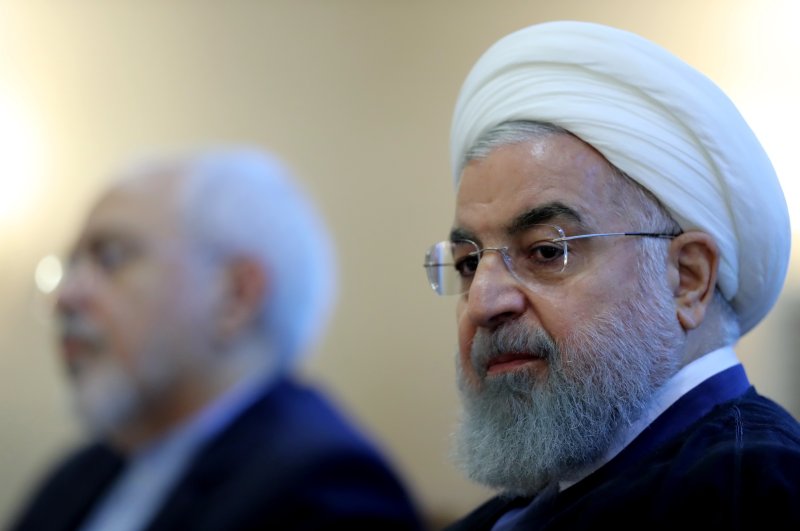Iranian President Hassan Rouhani (R) and Foreign Minister Mohammad Javad Zarif (L) during a ceremony in Tehran, Iran, 22 July 2018. The EIA said on Oct. 24, 2018 that it estimates Iranian production will be around 2.8 million barrels per day in 2019, lower than 3.8 million barrels in April, as a result of the sanctions. Uncertainty remains about how much, and how, will continue to be exported. Photo :EPA-EFE/Iran presidential office.
Oct. 24 (UPI) -- The Energy Information Administration said Wednesday that Brent futures will average $75 per barrel in 2019 and that once sanctions are implemented Iranian oil production will continue next year at a rate of about 2.8 million barrels per day.
"The October Short-Term Energy Outlook assumes that the effects of sanctions will increase during the first few months of full implementation and that Iran's average crude oil production (excluding condensate) in 2019 will fall by approximately 1.0 million barrels per day from Iran's April 2018 production level of 3.8 million barrels per day," the agency said in its report.
"This decline is similar to the drop in Iran's crude oil production that occurred when sanctions on Iran's Central Bank were imposed in 2012," it said.
According to the latest OPEC production report, Iranian oil production had come down to 3.4 million barrels per day as of September.
Iranian net oil export revenues were estimated at $55 billion last year, it added. The share of income that the country will lose will depend "on the response from OPEC (Organization of Petroleum Exporting Countries) members and other countries," the report said.
It said that there is uncertainty also whether other producers would help compensate for projected losses in Iranian supplies.
OPEC spare production capacity in 2018 of about 1.6 million barrels per day will fall to 1.3 million barrels per day in 2019, down from 2.1 million barrels per day in 2017, it said.
"This decline creates a market with relatively low spare capacity at the same time Iran and Venezuela are forecast to experience production declines," it said.
Higher crude oil prices in the end of 2018 and 2019, in comparison with the four previous years, will likely motivate producers globally to increase output.
EIA forecasts U.S. crude oil production will increase by 1 million barrels per day in 2019.
As for global liquid fuels inventories, they will increase by 280,000 barrels per day in 2019 compared with a projected decrease of 200,000 barrels per day this year.
The EIA projection came after a sharp decline in Brent prices so far this week. Brent futures on Wednesday as of 9.26 a.m. EST were trading at $76.87 per barrel, or nearly 0.6 percent higher from the opening. However, the futures dropped sharply from above $80 per barrel at the start of a week, a level it had sustained for nearly a month.
EIA's projection are higher than expectations from the CEO of BP, Bob Dudley, provided on October 10, just hours after Brent futures had hit a peak above $85 per barrel.
Dudley said at the time that BP was assuming, for its own planning, Brent futures levels of about $60 to $65 per barrel after a short volatility period. Prices would come down in large part because of a large expansion in U.S. production next year.
U.S. production is projected to increase to 11.7 million barrels per day next year, compared with 10.7 million this year, due to Permian basin production.
U.S. nuclear program-related sanctions against Iran will go in effect by Nov. 5. The U.S. has closed the U.S. financial system to Iran and seeks to prevent global companies from dealing with the country.
Uncertainty over future Iranian exports remains high. There have been reports that companies in different parts of the world would defy sanctions and continue buying Iranian oil. Market participants have also discussed the possibility that the U.S. would issue waivers.















